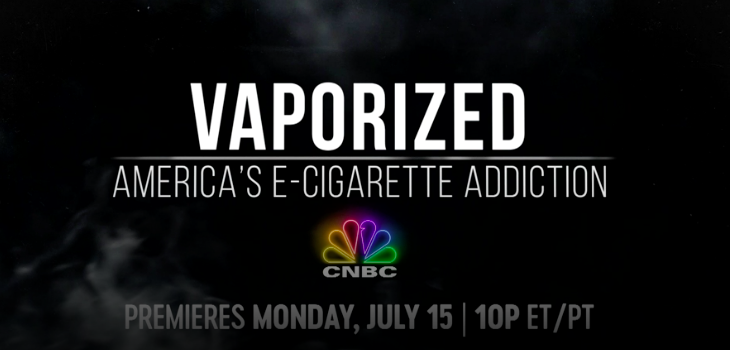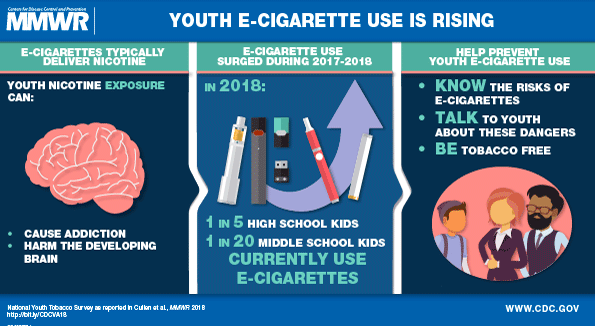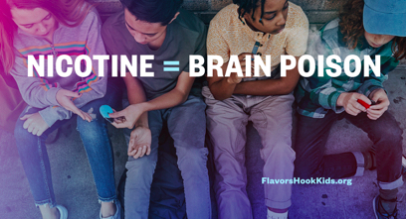 July 20, 2019 Health advocate colleagues are confused as to why I’m not wildly applauding the SF ban on e-cigs, given my staunch stance against Juul and other flavored “vaping gone viral” profiteers that have targeted and hooked youth via high doses of nicotine…especially after co-viewing this week’s CNBC special Vaporized with youth.
July 20, 2019 Health advocate colleagues are confused as to why I’m not wildly applauding the SF ban on e-cigs, given my staunch stance against Juul and other flavored “vaping gone viral” profiteers that have targeted and hooked youth via high doses of nicotine…especially after co-viewing this week’s CNBC special Vaporized with youth.
To explain… Behavioral psychologists in adolescent development have repeatedly confirmed the “forbidden fruit” attraction to what is prohibited as a motivational trigger for youth rebellion, with workarounds achieving the exact opposite results intended by a ban…so I’m not sure the efficacy is viable. Sure didn’t work during the rum runner prohibition era and as a parent, well, anecdotal evidence abounds.
From schools to homes, one can almost set a ‘workaround’ countdown clock for how fast teens will use alternative means to break a ban imposed by others, whether it involves cellphones, curfews, parental control filters on screens or peer group preferences.
We’ve all got empirical data we can cite, in fact I’ve used ‘banned books’ to encourage reading along with other marketing tactics to ‘sell’ reluctant readers, and have even strategically deployed teens to “break” apps aimed at tracking and surveillance to prove the point that there’s a fast workaround for most everything. Parenting wise, respectful mentoring over monitoring is the way to go with most adolescent behaviors to avoid them simply gaming the system.
Journal of the American Medical Association (JAMA) Pediatrics recent study involving 1.4 million high school students with the CDC Youth Risk Behavioral survey seems to bear witness to this as well, showing an actual DECLINE in teen use of marijuana in states where pot was legalized and openly available vs contraband.
JAMA stopped short of a causation link, but cited a strong corollary in legalization having a neutral or even opposite effect, which surprised the hand-wringers envisioning a nation of stoned zombie students shortly after cannabis laws changed in certain states.
ANY tactic that can discourage substance use among teens I’m all for, it just seems there might be more effective ways to outreach, instill agency, elicit peer influence, and counter-market behavior without feeding into an ‘us vs them’ dichotomy that fuels a ‘forbidden fruit’ dynamic via ban.
 That said, it’s understandable why adults are scrambling for ANY kind of solution fast, given that the regulatory lag and drag by the FDA is only now kicking into high gear, now apparently the “FDA is standing ready” to accelerate review of e-cigs even though public health advocates and youth concerns have been trying to quell this nicotine arm’s race for several years now, as vaping has been declared “epidemic” among US youth with federal data hovering at 3 million youth last year and skyrocketing increases continuing. (78% for high schoolers and up 48% for middle schoolers between 2017 and 2018 alone)
That said, it’s understandable why adults are scrambling for ANY kind of solution fast, given that the regulatory lag and drag by the FDA is only now kicking into high gear, now apparently the “FDA is standing ready” to accelerate review of e-cigs even though public health advocates and youth concerns have been trying to quell this nicotine arm’s race for several years now, as vaping has been declared “epidemic” among US youth with federal data hovering at 3 million youth last year and skyrocketing increases continuing. (78% for high schoolers and up 48% for middle schoolers between 2017 and 2018 alone)
All the more reason it’s important that health advocates don’t “spin their wheels” and put the brakes on a car already spinning out of control to make the matter even more dangerous, as a nation we need to get a handle on effective best practices to counter-market this public health scourge.
Often, it’s fastest and most efficient to go directly to the source to glean what works and what doesn’t, BEFORE implementing next steps, so in today’s post we’ll do just that, asking YOUTH themselves for their input on perceptions and realities with vaping and in part five, we’ll ask youth what tactics they feel might work best to get health harms front and center with education delivered sans preach and teach tactics.
Recap Part 1-4 in Our E-Cigs Series
To recap, Juul and other flavored vaping purveyors should be fully accountable for their media and marketing bait and switch to addict youth early on in a naïve “it’s less harmful than cigarettes” approach of false equivalence…
Without a doubt, Juul’s recent “I’m sorry” apologist routine is brazenly deceptive and duplicitous and needs called out…loudly. But a ban is not necessarily the answer, as we saw in part two deconstructing the special interests involved with vaping legislation, as what “sounds” like a hard stop can turn out to enable gaping loopholes.
 Asking the health experts in tobacco cessation for their approach to getting the word out on the health harms helped add to the best practices in part three, so trial ballooning college aged youth themselves seemed like a logical part four, tethered to the viewing of this week’s CNBC special report on vaping titled, “Vaporized: America’s E-Cigarette Addiction” which hit the airways Monday night. (again, watch it on demand here)
Asking the health experts in tobacco cessation for their approach to getting the word out on the health harms helped add to the best practices in part three, so trial ballooning college aged youth themselves seemed like a logical part four, tethered to the viewing of this week’s CNBC special report on vaping titled, “Vaporized: America’s E-Cigarette Addiction” which hit the airways Monday night. (again, watch it on demand here)
We invited a half-dozen hand-selected co-viewers into my home to watch the show, comprised of two self-described “perpetual” vapers, two non-vapers and two ‘tried it but not my thing’ students who all are SF Bay Area based, and thus keenly aware of the new Juul ban and precedent-setting politics.
In a casual Q&A conversation, we started at a baseline to find out how much they knew about vaping, which led into the dialogue about specifics on what they think about vaping bans. To get a bead on how they perceive the rise of big industry in the mix I divulged my bias about the concerns on health misinformation and lack of education.
Framing my bias honestly is key, as it’s something these vaping behemoths don’t do at all, given their covert tamping down of risk factors, lack of longitudinal research and safety concerns and cruddy cues that place youth bodies at developmental risk rendering them into human petri dishes.
We talked a lot about existing pro/con narratives, influencers up for sale, and whether the whole ban concept would be effective, from a regulatory lens once youth became ‘legal’ at 21.
A few of the before/after conversational take-aways on banning are summarized below:
Before Watching Vaporized: A Youth Lens on the SF Ban
“I think adults need to calm the *&%* down. Banning e-cigs while allowing regular cigs in SF is just stupid. Memes are already everywhere making fun of the hypocrisy. I mean, seriously? Teens in SF run into weed, meth, heroine and cigs on the streets but gawd forbid they light up a Juul? That’s just dumb.”
“I think adults are asking the wrong questions. It’s not how do we stop youth from access and Juuling, it’s how do we educate them so they know what they’re putting in their bodies BEFORE they do it.”
“I think they should regulate, not ban e-cigs; I say make it harder for young kids to get it, hold retailers responsible, jack up the prices, treat it like any kind of smoking in CA where you’re basically set outside like the trash and it will self-correct. If they just got rid of all the flavors…that’d help…THAT’s what’s attracting the kids…”
“Ban it for now, sure, but then what? If SF is going to regulate behavior, that’s a Pandora’s box you don’t wanna open. I’m not a vaper, but this sounds like just a positioning policy until they get the FDA to rule on regulations…it’s a pass the buck thing to say ‘no, Juul, you can’t keep selling here,’ while the feds get their act together. At least that’s my interpretation from reading the Times.”
“I think talking about the manipulation works…older kids talking to younger kids, maybe college to HS, then HS to middle school…but adults and bans? No. Parents and teachers have been all over this and it’s not working. It’s obvious Juul is lying when they say they didn’t market to kids, I SAW it take off…my friends in high school days were all over the stuff…the damage is done already. If I were a parent with an addicted kid, I’d be pissed too, but an SF ban won’t help that. I’d call them out and protest on social media, cause Juul shouldn’t be sponsoring s*. They should be fined, taxed, dragged and put on blast. If it were a youth campaign, that’d be more effective…Festivals, concerts, campuses…Insta…Snapchat…make it stupid to Juul.”
After the Vaporized show: Youth React & Reflect
“No big surprises, except maybe how much plastic waste there is in the behind the scenes production of Juul…Maybe take a big pharma/big tobacco anti-green message on waste as well as the wasted body impact of chemicals…Sky high price points and closing loopholes like online sales would do more than a ban.”
“If you could get “influencers” who YouTube all the vape tricks to talk about their own bodies and any changes they’ve experienced…that might work. It’s the subtle changes that matter…like the kid that said he was out of breath more. Scare tactics and gross pictures work with meth, but vaping will come off as over-reaction because the narrative has been that it’s not a big deal…Some of my friends STILL think it’s about ‘vapor’ not nicotine so that needs debunked first.”
“That hour just made me need to light up. I’m going to go hit my Juul, ha. Kidding, sorta. Maybe rather than ‘I’m sorry’ they should fund ways to get us OFF the pods? I haven’t really TRIED to stop…but admit I’m on it, big. I started in high school and now first thing in the morning I hit the Juul and last thing at night before bedtime too…Now, I ALSO smoke tobacco, and weed, socially…it’s just always there. The ban won’t keep me from it, I just won’t buy in SF. It’s already expensive, and banning flavors is kind of random, because I also smoke mint, menthol and tobacco flavor, I have to quit when I’m ready…”
“The points they made by region at the end were interesting. In CA, smoking is gross, but Juuling is more acceptable, depending on your group because the smoke doesn’t linger as long. In the UK, smoking cigarettes is pub culture and vaping is more of a public health solution to that, so it it makes sense the UK would want to shift people off tobacco to something less cancer causing…In the US, youth weren’t really smoking to begin with, numbers were way down, so that whole “I’m sorry” speech hit me as BS, because now there’s a use problem. Regulatory bans will be all over the board if they go the regional route…users by region have different smoking social stigmas (Kentucky, West VA, the south vs the coasts, big cities, etc.) but I guess it’s worth a shot if middle schoolers are vaping; reminds me of the Red Bull freebies back in the day. It needs to be regulated and die out.”
“This is going to sound weird, but the poor rats trapped in the cages sucking up the Juul smoke made me sad and mad…it’s a living being. How can they DO that to the poor thing? Extrapolate that to youth and well…Boom. I’d go that route because bathrooms in my high school were thick with smoke. What is it doing to those who DON’T Juul? Do we even know?”
“I’m hoping vaping is a trend and it’ll just burn out. I just worry about my little brother, like, is HE using? It was never in my social circle, at my school it was more of a subculture, like Hookah…not my group. Those stats make me wonder if he’s vaping and my folks don’t know it. I’m not around anymore to keep an eye on him. He’s an athlete though, so probably not?”
“Um…our whole team vapes, sooooo that’s not a good argument…it’s more environmental, social. When I started vaping I had no clue all the crap that was in it… I think educating on the health risks beyond lungs is big; vaso-constriction/cardiac part got my attention as an athlete vaper, but then again, we all know about brain cells and binge drinking too and has that stopped us? Still, it should be MY choice if I’m going to be stupid…I don’t think the health harms are really being taken seriously, everyone just shrugs it off…the addictive thing over say a decade of messing with it could be huge, we don’t know what we don’t know.”
“I think ‘epidemic’ is a hype word. Youth will tune out if they don’t see it happening in their own world. It’s one thing to try it because the flavors are fun, it’s another to “need” the nicotine again and again. The way it burned my throat I knew right away that’s not something I want in my system…Smokers are already used to that burn, so they didn’t need Juul to engineer a less harsh version unless they were going after a new audience. That seems like a smoking gun for the “I’m sorry” guy who gave the ‘we never meant it for youth’ argument. And that stat on middle schoolers using? That’s messed up. If it’s really about helping adults get off cigarettes, they should be able to ban all the candy flavors, right? Maybe bring the conversation into life sciences class.”
“Wanted to add, banning is local politics here… SF is flexing to say “not in my backyard” because its Juul’s home turf and they want to send a ‘get tough’ signal…There’s no ban on tobacco so why would they ban e-cigs? It makes them look like they’re doing something…anything.”
Next up, in Part 5, we’ll highlight high schoolers from colleague Rosalind Wiseman’s aligned organization, Cultures of Dignity along with a compilation of e-interview answers from a larger age range including youth advisory board members, editors, interns and champions of student voice…Stay tuned!
Again, if you haven’t seen the show“Vaporized: America’s E-Cigarette Addiction” it’s On Demand here. As always, leave your feedback in the comments…we’d love to hear from middle schoolers too, as we don’t have a group represented there yet.









Speak Your Mind